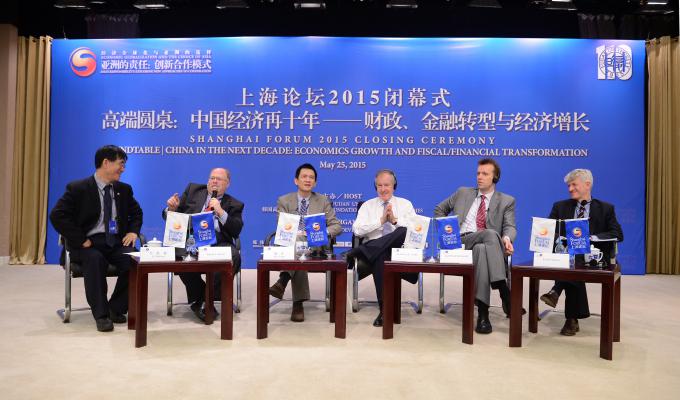Scholars explore innovative cooperation model for Asia

Scholars talk about China in the next decade from the perspectives of economic growth and financial transformation.
Asian countries share the historical mission of common development, but the lack of a cooperation platform resembling the European Union has posed challenges to regional cooperation. The Shanghai Forum 2015, held from May 23 to 25 and themed “Economic Globalization and Asia’s Choice—Asia’s Responsibility: Exploring New Approaches to Cooperation,” gathered more than 500 delegates from nearly 40 countries to probe a mechanism for fruitful cooperation in the region.
Since economic growth, social governance, poverty elimination and modernization are essential paths to regional prosperity and stability, Asian countries face the pressing task of crafting innovative cooperation systems.
Because one-third of the Asian population is poor, “poverty is the biggest problem in Asia,” said Chintamani Mahapatra, a professor from Jawaharlal Nehru University in India. Restrictions of inferior education and lasting impacts of issues left over from history have intertwined, making it difficult to find a surefire way out, he said.
Economic globalization and advancements of science and technology have instead weakened the problem-solving capacity of Asian countries, so cooperation is vital to ensure common safety and prosperity, Mahapatra said.
“However, existing cooperation platforms in Asia are in need of systems that are as well-rounded, effectual and institutional as those in Europe,” said Lin Shangli, vice-president of Fudan University, adding that if Asia can get somewhere in the construction of a cooperative mechanism, the continent will make fuller contributions to the world.
Asian countries are vastly different in terms of population, ethnic groups, language and culture, which, to a large degree, is the root cause containing regional security and development.
“Despite huge differences, the prospects for overall cooperation in Asia are optimistic. Countries concerned have devoted forceful efforts to their own development and realized that only cooperation can provide more opportunities for themselves. It can be predicted that an innovative cooperation model will generate far-reaching effects on the building of the Asian common-destiny community,” Lin said.
Masood Khan, president of the Institute of Strategic Studies in Islamabad, Pakistan, said it is essential to realize cooperation among more countries through economic ties. Nevertheless, such cooperation must go beyond the economic sphere and include broader dimensions, he said.
Khan claimed that China will be the hub to stabilize Asia. In the future, when China becomes the base for Asian stability, ties among regional countries will be strengthened, he added.
The “One Belt, One Road” initiative, the Asian Infrastructure Investment Bank (AIIB) and the Silk Road Fund were buzzwords mentioned from time to time at the forum, leading scholars to identify all as innovative cooperation models for Asia.
According to the World Bank , Asia needs $800 billion for infrastructure construction annually, but the World Bank and the Asian Development Bank can supply only $30 billion. Although Asian countries themselves are able to raise about $200 billion to $300 billion, there is still a vast gap in infrastructure investment.
Developing economies in Asia, including China, invested approximately $440 billion abroad in 2014, overtaking North America and Europe for the first time. Investment was largely utilized in infrastructure construction, contributing remarkably to the recovery of the world economy.
The AIIB and the Silk Road Fund are both inseparable from the financial system, said Myron Scholes, a Nobel laureate in economics and honorary professor of finance at Stanford University. He said the key to the Asian innovative cooperation model lies in the integration of financial systems.
As information technology progresses, financial systems in Asia have become more open, flexible and customized. Only by combining capital with “creativity” can innovative products and services be derived. The support of capital for innovation is extremely important to the development of China, Asia and even the world, he said.
Innovation, however, means taking risks. In terms of technological innovation and economic transition in Asia, how to manage, transfer and hedge against risks is unavoidable. Only by establishing a sound risk-management system and empowering the market to help enterprises or individuals share risks can Asian countries shift focus to the most productive industries, Scholes said.
Cultivating high-quality human resources also presents a common challenge to Asian countries. “The quantity and quality of human resources determine the development of various fields in the foreseeable future,” said Jaeho Yeom, president of Korea University.
By paying more attention to human resources in Asia, Yeom said Asia can become a new center for technological innovation and economic development, Yeom said. To this end, Asian countries must take education as a point of departure to create a new cooperation environment that allows young people to bring their creativity and potential into play to advance economic and social reform in Asia.
According to the Shanghai Forum 2015 Consensus released at the closing ceremony of the forum, in the face of profoundly changing world pattern and new economic situation, Asia has the wisdom, confidence and responsibility to contribute a fresh cooperation model to the world and set out on a new development path.
The forum, which held 10 sessions, was co-sponsored by Fudan University and the Korea Foundation for Advanced Studies.
Li Yu is a reporter at the Chinese Social Sciences Today.

 PRINT
PRINT CLOSE
CLOSE